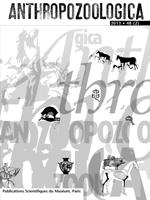Ranging from the valves of exotic marine shells (Spondylus) to anthropomorphic figurines fashioned on metapodials, and from carnivore tooth beads to the deposition of partial carcasses, the representation of fauna in the graves of the early Neolithic in northern France and in the upper Rhine valley takes very diverse forms. This contribution focuses on those remains which can be associated with the practice of food deposits in order to better define the modalities of this type of such finds (choice of species and body parts, preparation, arrangement and position in the grave), understand their meaning and outline their characteristics in relation to other categories of animal bone items (ornaments, tools…) which form part of the grave assemblage.
How to translate text using browser tools
1 December 2013
Food offerings in graves from the Danubian Neolithic (5500–4900 B.C.) in the upper Rhine valley
Rose-Marie Arbogast
ACCESS THE FULL ARTICLE
It is not available for individual sale.
This article is only available to subscribers.
It is not available for individual sale.
It is not available for individual sale.

Anthropozoologica
Vol. 48 • No. 2
December 2013
Vol. 48 • No. 2
December 2013
Animal offering
Dépôts alimentaires
grave
NEOLITHIC
Néolithique
Plaine du Rhin supérieur
sépulture




